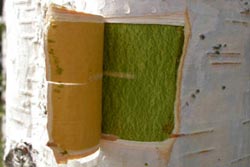Birch Helps Wounds Heals Faster

Birch bark extract is prepared from the outer white layer of the tree. © Armin Scheffler<br>
Extracts from the birch tree have served for centuries as a traditional means of helping the damaged skin around wounds to regenerate more quickly.
Prof. Dr. Irmgard Merfort from the Institute of Pharmaceutical Sciences of the University of Freiburg and her team have now explained the molecular mechanism behind the wound-healing effect of an extract from the outer white layer of the tree’s bark. The scientists published their findings in the journal Plos One.
The team cooperated with several other departments and institutes, such as a research group from the Institute of Molecular Medicine and Cell Research and the Institute of Experimental and Clinical Pharmacology of the University of Freiburg as well as a research group from the Dermatological Clinic of the University of Hamburg.
In the first phase of wound healing, the damaged skin cells release certain substances that lead to a temporary inflammation. They attract phagocytes, which remove foreign bacteria and dead tissue. The Freiburg scientists determined that the birch bark extract, in particular its main ingredient betulin, does in fact temporarily increase the amount of these inflammatory substances. The natural substance activates proteins that extend the half-life of the messenger ribonucleic acid (mRNA). A gene must first be translated into mRNA for the blueprint of a protein to be read by the genome. The substance triples the time in which the mRNA of a particular messenger remains stable. This messenger enables more of the protein in question, in this case the inflammatory substances, to be produced. In addition, the birch bark extract and betulin also stabilize the mRNA of further messengers.
In the second phase of wound healing the skin cells migrate and close the wound. The natural substance aids in this process: The birch cork extract and its components betulin and lupeol activate proteins that are involved in the restructuring of the actin cytoskeleton, which gives the cell its shape with the help of the structural protein actin. In this way, the substances from the birch cause keratinocytes – the most common type of cell in the outermost layer of skin – to migrate more quickly into the wound and close it.
Original Publication:
Ebeling, S./Naumann, K./Pollok, S./Vidal-y-Sy, S./Wardecki, T./Nascimento, J. M./ Boerries, M./Schmidt, G./Brandner, J. M./Merfort, I. (2013): From a traditional medicinal plant to a rational drug: understanding the clinically proven wound healing efficacy of birch bark extract. In: PLOS ONE. DOI: 10.1371/journal.pone.0086147
Article in uni’wissen:
www.pr.uni-freiburg.de/go/wundheilung
Contact:
Prof. Dr. Irmgard Merfort
Institute of Pharmaceutical Sciences
University of Freiburg
Phone: +49 (0)761 / 203-8373
E-Mail: irmgard.merfort@pharmazie.uni-freiburg.de
Media Contact
All latest news from the category: Life Sciences and Chemistry
Articles and reports from the Life Sciences and chemistry area deal with applied and basic research into modern biology, chemistry and human medicine.
Valuable information can be found on a range of life sciences fields including bacteriology, biochemistry, bionics, bioinformatics, biophysics, biotechnology, genetics, geobotany, human biology, marine biology, microbiology, molecular biology, cellular biology, zoology, bioinorganic chemistry, microchemistry and environmental chemistry.
Newest articles

Silicon Carbide Innovation Alliance to drive industrial-scale semiconductor work
Known for its ability to withstand extreme environments and high voltages, silicon carbide (SiC) is a semiconducting material made up of silicon and carbon atoms arranged into crystals that is…

New SPECT/CT technique shows impressive biomarker identification
…offers increased access for prostate cancer patients. A novel SPECT/CT acquisition method can accurately detect radiopharmaceutical biodistribution in a convenient manner for prostate cancer patients, opening the door for more…

How 3D printers can give robots a soft touch
Soft skin coverings and touch sensors have emerged as a promising feature for robots that are both safer and more intuitive for human interaction, but they are expensive and difficult…





















